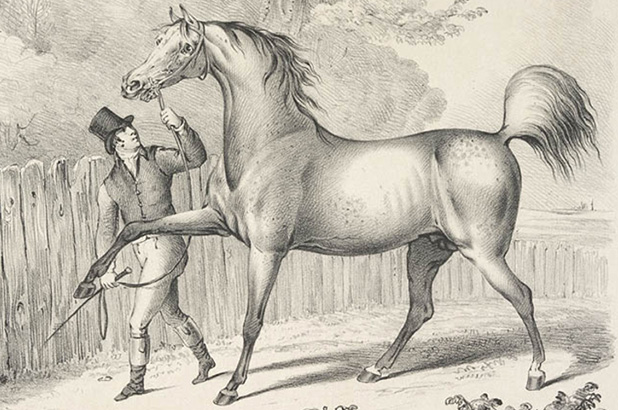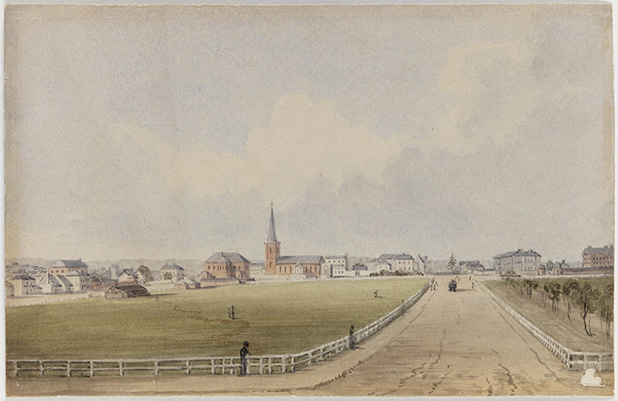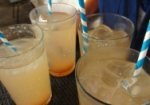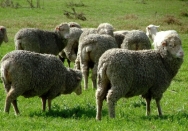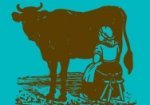As we reach the end of October the racing season looms. So in honor of the nation’s hardworking milliners here’s a look at the start of Sydney’s annual horse races and its first track, and a drink to cheer on the horses – Huzzah!
“I hoe, I hoe, it’s off to work I go”
In 1798, and all settled in at their new home at Parramatta, Elizabeth Macarthur wrote about the first plough in the colony being used at their Elizabeth Farm, “drawn sometimes by oxen and at others by horses”. The settlement’s other fields were being laboriously tilled by hand, by convicts with hoes. It wasn’t a case of ‘hard labour’, it was simply that there weren’t yet enough draft animals available in the colony to go round. A good horse, Elizabeth wrote, sold for £140-150, “be it ever so bad it never sells for less than £100. A cow is valued at about £80… you will perceive that those persons who took early precautions to raise stock have at present singular advantages”.
It also meant that the earliest fields and vegetable gardens hadn’t been able to be enriched with animal manure, which was essential in the very sandy soils around the Sydney settlement (at Vaucluse House our gardens team enriches the sandy soil of the kitchen garden with truckloads of stable waste, and the garden volunteers at Rouse Hill collect the contributions of our cows). Simply getting around also had its limitations; you may have seen the illustration of a cart full of passengers being pulled along by a team of convicts. Getting to and from Parramatta was relatively easy by boat, while ‘Shank’s pony’ was the only option for most.
Jump forward 15 years and haven’t things changed! Intensive stock breeding and new arrivals meant that horses were common in the fields, carriages were frequent to the point that a new road from Parramatta to Windsor would soon be needed that cut out the steeper hills and Sunday drives would become quite the thing. Families like the Macarthurs enjoyed kangaroo hunts, and it wasn’t long before the colonial gentry turned their mind to that preserve of the well-healed: horseracing. Following races held at Parramatta and the Hawkesbury settlements, in 1810 the Sydney Race Club was formed, with Lachlan and Elizabeth Macquarie as its patron and patroness. Typical of the new Governor’s projects, the first Sydney Races was seen as an ‘improving’ project both for the colony’s horse-stock and its moral character (which begs the question, does anyone know when the phrase “colourful racing identity” was first coined?).
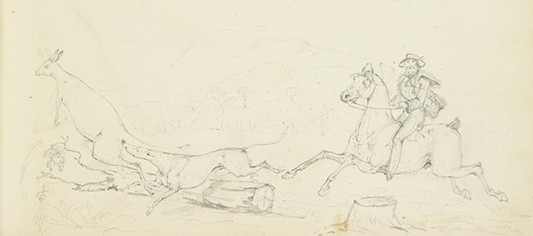
G. Hamilton : album of sketches (detail), George Hamilton, ca. 1836. State Library of New South Wales: PXA 2072
You can never have too many ‘huzzahs’ (apparently)
At a dinner in August 1810 the first seasons races were announced, with the requisite toasts and huzzahs:
On Monday last the Subscribers to the Sydney Race Course dined together to celebrate the Aniversary of His Royal Highness the Prince of Wales’s Birth-Day.—His Excellency the GOVERNOR, who has been graciously pleased to patronize the Establishment, and His Honor the LIEUTENANT GOVERNOR, honored the Party with their Presence.—The evening was passed with the utmost conviviality and harmony, and the Company retired highly gratified with their entertainment. The following were the Toasts drank on the occasion, and reiterated amidst general acclamations; 1 The King. 2 The Queen. 3 The Prince of Wales. 4 The Duke of York and the rest of the Royal Family. 5 Lord Mulgrave and the Navy. 6 Sir David Dundas and the Army. 7 His Excellency Governor Macquarie and the Colony. 8 Mrs. Macquarie, the Patroness to the Races ; and the Ladies of the Colony. 9 The Turf, &c. &c.
Nice to see the turf gets a mention. Then the interesting details:
The Races commence on Monday the 15th of October, and will continue until the Friday following, with the omission of Tuesday and Thursday. The Course has been compleated at a very considerable expence, and is esteemed a very fine one. Several handsome plates and other elegant presents, among which is a silver cup of 50 guineas value, given by the Ladies of the Colony, are to be contended for by the horses of Subscribers to the Race Course; and a purse of 50 guineas will be given by the Magistrates of the Colony, free for all horses, to be run for the last day. From this excellent institution, so liberally patronized and supported, we may hope the important advantage of amending the breed of the most useful and most noble animal that nature has bestowed on man. (The Sydney Gazette, 8 September 1810)
But where was the track? If you’re from Sydney you’ve probably walked through it countless times without knowing it: Hyde Park!
This view is along what is, today, the central pedestrian avenue. Looks rather different without the fig trees doesn’t it. The track ran around and through the park, and was also open to race subscribers for genteel driving, riding and promenading – with a proviso:
The Non-Subscribers to the Sydney races are hereby strictly forbid driving or riding Horses on the Course, without Permission of the Stewards, It is hoped the Subscribers will see the necessity of keeping on the outer Edge, when they drive or ride round the Course, as the Damage already done to it by Carriages driving near the Posts must be obvious to every person. (The Sydney Gazette, 2 February 1811)
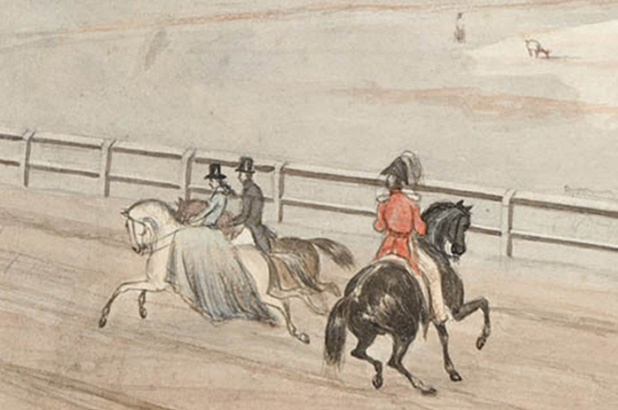
Hyde Park, St James Parsonage Dispensary, afterwards the Mint, and Emigration Barracks (detail), John Rae, 1842. State Library of New South Wales: DG SV* / Sp Coll / Rae / 16
And they’re off!
On the first and second day’s racing D’arcy Wentworth’s prize horse Gig was one of the winning horses; on the second day ridden by his son, the future politician and legal reformer William Charles. Several horses, like D’arcy’s Gig, were raced by their owners. Captain Piper would quite likely have ridden his own horse, the wonderfully-named Miss Kitty (other horses racing included Strawberry, Billy, Jerry, Chase, Rattler, Hyderabad and Bryan-Boroo), if he weren’t recuperating from a badly broken arm suffered a fortnight before when, promenading around the Park, a dog had run at his horse and spooked it. Dogs were a big issue in the streets of Sydney, so much so that, preparing for the races, the Stewards announced “All Dogs found on the Course after this Notice will he shot.” (Gazette Saturday 29 June 1813). No-one told the dogs though:
The fall received by Mr. Wentworth’s Gig in the first heat on the last day was occasioned by a dog crossing the Course. The rider (Fisher) was too much hurt to recover himself in time to re-mount, but the horse was not much injured by his fall. A similar accident had nearly befallen Mr. Benn’s Scratch the second heat being so much startled by a dog as to fly off, and run considerably out of his track; which was however attended with no bad consequence, being far a-head of his antagonist. (The Sydney Gazette Saturday 20 October 1810)
A society do
Crashes and errant dogs aside, a good race meet has its social side, and this was no exception. I find it amusing that even by 1810 the papers distinguish between ‘town’ and ‘country’: “Parramatta, Prospect, Seven Hills, and Hawkesbury, up even to the Nepean, contributed to crowd the scene… Entertainments were given all over the Town, to welcome our country friends to our first jubilee; and as a great number had come from Hawkesbury, where the fortunate Scratch had long been a favourite, he was honoured with the fraternal embrace from most of his old acquaintance…” It was, said the Gazette, the The entertainments ranged from dinners to balls, and cockfights to novelty piggy-back races on the course. It was, said the Gazette, the largest collection of people in the history of the colony (The Sydney Gazette, Saturday 20 October 1810).
A CARD -The Subscribers to the Sydney Race Course are informed, that the Stewards have made Arrangements for Two Balls during the Race Week, Tuesday and Thursday,- Tickets at 7s. 6d, each to be had at Mr. E. Wills’s, George street. An ORDINARY for the Subscribers and their Friends each Day of the Races at Mr. Wills’s.- Dinner on Table at Five o’Clock. On Monday the Races commence, and continue Wednesday and Friday. Horses to start each day at one. For general information on the subject of these elegant sports, a Racing Kalendar will be in readiness at nine on Monday morning.-Price 6d.” (Sydney Gazette, Saturday, 13 October 1810)
While we don’t have the menus of these occasions, for a celebratory tipple to toast your winner – or forget your losses – how about the punch recipes we looked at recently, or Eliza Acton’s easy recipe for a mint julep. Just remember to ‘Huzzah’!
Mint Julep – an American Receipt
Strip the tender leaves of mint into a tumbler and add to them as much wine, brandy or any other spirit, as you wish to take. Put some pounded [crushed] ice into a second tumbler [or use a cocktail shaker] and continue to pour the mixture form one tumbler to the other, until the whole is sufficiently impregnated with the flavour of the mint.
(Eliza Acton, Modern Cookery for Private Families, 1845.)
Brandy or whiskey – especially Bourbon – are traditional, and I’d suggest muddling the mint with some sugar first to develop the taste. Eliza notes that a Julep is “like most other iced American beverages, to be imbibed through a reed” – in other words a straw, and that the mix should be poured into a larger glass with more pounded ice so that the frost would develop on the outside. For this reason a Mint Julep is traditionally served in a silver cup. As you do.
Notes as to the huzzahs:
General Sir David Dundas (1735-1820) was commander-in-chief of the British Forces from 1809 to 1811.
Henry Phipps, The Lord Mulgrave (1755 – 1831) was First Lord of the Admiralty from 1807-1810, then Master General of the Ordnance from 1810-1819.
The identity of the dog that unseated Captain Piper remains unknown.
